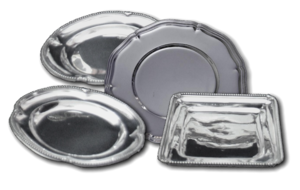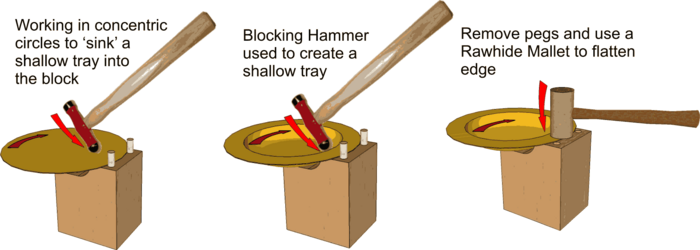Sinking
From DT Online
Description
Sinking is a process used to create flat, shallow tray forms (i.e. Flatware) by beating an Annealed sheet metal shape into a recess formed in the end grain of a suitable block of close-grained Hardwood known as a Sinking Block. These are usually self-made to suit the job in hand.
Process
A metal disc is first marked out with the width of the desired rim and concentric guideline circles up to the depth of recess then Annealed.
The process involves holding the disc horizontally against a Sinking Block and rotating it by hand as it is struck with a Bossing Mallet or Blocking Hammer to 'sink' it into the shaped recess of the block. If a circular article is being sunk, two removable pegs or pins may be placed in the wood block to help control the width of the flat surface of the rim.
The rim and the base surface can be kept flat by removing the guide pegs and striking against the flat top of the block with a mallet. Alternatively, each surface in turn can be held against a Surface Plate and a piece of scrap wood laid over it, then struck with a hammer.
Once Sinking has resulted in a satisfactory shallow form, it can be trued, the metal Work Hardened and polished, by a process known as Planishing. It is important that the metal is thoroughly cleaned before Planishing (e.g. by Pickling and/or scouring) to avoid any grit, oxides or other contaminants being hammered into the surface.
- 12oz Hammers (0.45kg) are a good useful size for general work in Design and Technology.
- Larger 2lb hammers (1kg) are used for heavier work such as Blacksmithing for example.
- Smaller hammers (e.g. 4oz and 8oz) are suitable for jewellery work and model engineering applications.
- Brick Hammers between 1lb and 1.5lb weight (450g to 700g) are suitable for school use and are available also with a Scutch Comb Chisel at one end which can be used for shaping brick and masonry.
- A 2lb Lump Hammer (0.9kg) is a good useful size for general work in Design and Technology and home maintenance tasks.
- 2lb to 4lb Sledge Hammers (1-2kg) are a suitable size for general forge-work in Design and Technology since hammers heavier than 4lb would be difficult for students to use.
 |
 |
 |
 |
 |
 |
 |
 |
| Ball Pein Hammer |
Blacksmiths Hammers |
Brick Hammer |
Claw Hammer |
Cross Pein Hammer |
Lump (or Club) Hammer |
Pin Hammer |
Sledge Hammer |

